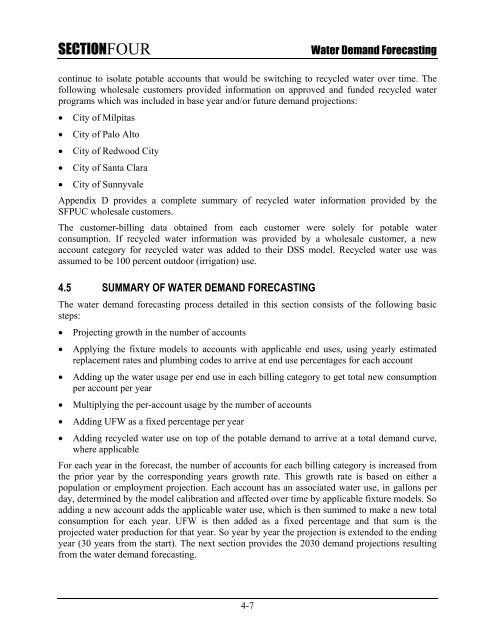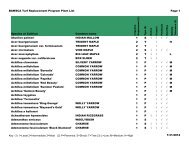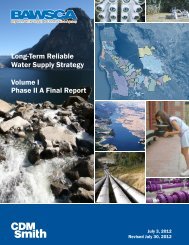SFPUC Wholesale Customer Water Demand Projections ... - BAWSCA
SFPUC Wholesale Customer Water Demand Projections ... - BAWSCA
SFPUC Wholesale Customer Water Demand Projections ... - BAWSCA
Create successful ePaper yourself
Turn your PDF publications into a flip-book with our unique Google optimized e-Paper software.
SECTIONFOUR<br />
<strong>Water</strong> <strong>Demand</strong> Forecasting<br />
continue to isolate potable accounts that would be switching to recycled water over time. The<br />
following wholesale customers provided information on approved and funded recycled water<br />
programs which was included in base year and/or future demand projections:<br />
• City of Milpitas<br />
• City of Palo Alto<br />
• City of Redwood City<br />
• City of Santa Clara<br />
• City of Sunnyvale<br />
Appendix D provides a complete summary of recycled water information provided by the<br />
<strong>SFPUC</strong> wholesale customers.<br />
The customer-billing data obtained from each customer were solely for potable water<br />
consumption. If recycled water information was provided by a wholesale customer, a new<br />
account category for recycled water was added to their DSS model. Recycled water use was<br />
assumed to be 100 percent outdoor (irrigation) use.<br />
4.5 SUMMARY OF WATER DEMAND FORECASTING<br />
The water demand forecasting process detailed in this section consists of the following basic<br />
steps:<br />
• Projecting growth in the number of accounts<br />
• Applying the fixture models to accounts with applicable end uses, using yearly estimated<br />
replacement rates and plumbing codes to arrive at end use percentages for each account<br />
• Adding up the water usage per end use in each billing category to get total new consumption<br />
per account per year<br />
• Multiplying the per-account usage by the number of accounts<br />
• Adding UFW as a fixed percentage per year<br />
• Adding recycled water use on top of the potable demand to arrive at a total demand curve,<br />
where applicable<br />
For each year in the forecast, the number of accounts for each billing category is increased from<br />
the prior year by the corresponding years growth rate. This growth rate is based on either a<br />
population or employment projection. Each account has an associated water use, in gallons per<br />
day, determined by the model calibration and affected over time by applicable fixture models. So<br />
adding a new account adds the applicable water use, which is then summed to make a new total<br />
consumption for each year. UFW is then added as a fixed percentage and that sum is the<br />
projected water production for that year. So year by year the projection is extended to the ending<br />
year (30 years from the start). The next section provides the 2030 demand projections resulting<br />
from the water demand forecasting.<br />
4-7







